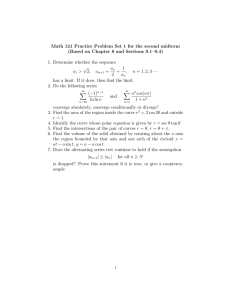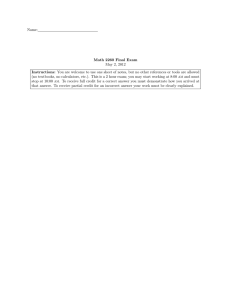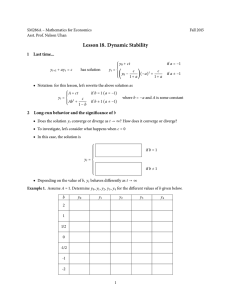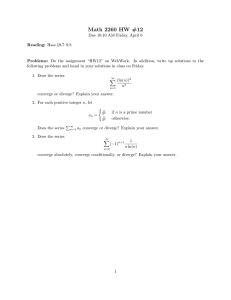MATH 104 – Practice Problems for Final Exam 1. Find the area
advertisement
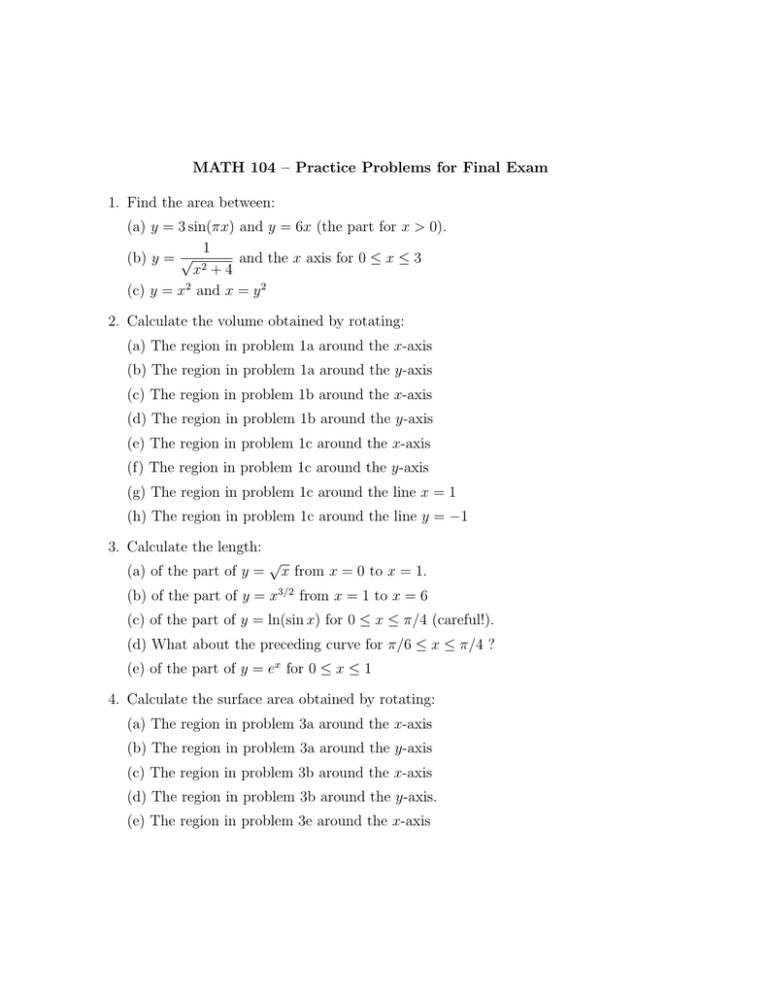
MATH 104 – Practice Problems for Final Exam 1. Find the area between: (a) y = 3 sin(πx) and y = 6x (the part for x > 0). 1 and the x axis for 0 ≤ x ≤ 3 (b) y = √ 2 x +4 (c) y = x2 and x = y 2 2. Calculate the volume obtained by rotating: (a) The region in problem 1a around the x-axis (b) The region in problem 1a around the y-axis (c) The region in problem 1b around the x-axis (d) The region in problem 1b around the y-axis (e) The region in problem 1c around the x-axis (f) The region in problem 1c around the y-axis (g) The region in problem 1c around the line x = 1 (h) The region in problem 1c around the line y = −1 3. Calculate the length: (a) of the part of y = √ x from x = 0 to x = 1. (b) of the part of y = x3/2 from x = 1 to x = 6 (c) of the part of y = ln(sin x) for 0 ≤ x ≤ π/4 (careful!). (d) What about the preceding curve for π/6 ≤ x ≤ π/4 ? (e) of the part of y = ex for 0 ≤ x ≤ 1 4. Calculate the surface area obtained by rotating: (a) The region in problem 3a around the x-axis (b) The region in problem 3a around the y-axis (c) The region in problem 3b around the x-axis (d) The region in problem 3b around the y-axis. (e) The region in problem 3e around the x-axis 5. Integrate: (straightforward) (a) (b) (c) (d) (e) Z x4 ln(2x) dx Z x2 cos(3x) dx Z x2 Z Z √ √ x+2 dx + 8x + 15 1 − 4x2 dx 1 dx x−1 sin2 (ln x) (f) dx x Z sec2 (ln x) q (g) dx x 1 − tan(ln x) Z 6. Integrate: (trickier) Z cos4 (2x) dx Z √ 2 x + 16 (b) dx x Z et (c) dt e2t + 4 Z √ 1 − e2x dx (d) (a) (e) Z cos √ x dx 7. Evaluate: Z ∞ 1 dx x(ln x)2 e Z ∞ dx (b) (x + 1)(x + 4) 0 (a) (c) Z 1s 1−y 0 y dy 8. For a certain value of k, each of the following functions is a probability distribution. Find the value of k, and then find the mean and median of the distribution. Also find the probablity that x > 1 for each distribution. (a) f (x) = 3ekx for x > 0 (zero otherwise) k (b) f (x) = for all x. 1 + x2 (c) f (x) = k ln(2 + x) for 0 < x < 2 (zero otherwise, you’ll have to settle for an approximate value for the median). 9. Solve the initial-value problem: (a) y 0 + y = 2, y(0) = 1 dy (b) = 1 − y + x2 − yx2 , y(0) = 0. dx (c) y 0 − xy = x, y(0) = 3. 10. Suppose the rate of change of a quantity y is proportional to ******, and y(0) = 1 and y(1) = 2, then what is y? (a) ******* is y itself (b) ******* is y 2 √ (c) ******* is y (d) ******* is y + 1. 11. Find the limit of the sequence: ( ) ln(1 + 3/n) (a) sin(2/n) n+1 n (b) n+2 n (c) (3n + 5n )1/n o 12. Which series converge? (straightforward) (a) (b) (c) (d) (e) ∞ X n3 n n=1 3 ∞ X n3 4 n=1 1 + n ∞ X n3 5 n=1 1 + n ∞ X cos2 n −n n=1 1 + e ∞ X en n=1 n! 13. If you put (−1)n into each of the series in the preceding problem, which ones converge absolutely, converge conditionally, or diverge? 14. Which series converge (trickier) (a) (b) (c) (d) ∞ X 1 2 n=2 n(ln(n) ) ∞ X n=1 ∞ X n4 ln(n!) + 2n + 1 tan(1/n) ln n n=2 ∞ X s n=1 en n! 15. If you put (−1)n into each of the series in the preceding problem, which ones converge absolutely, converge conditionally, or diverge? 16. For which x do the following series converge? ∞ X (x + 2)n (a) n n=1 (b) (c) (d) ∞ X (x − 3)n 2 n=1 1 + n ∞ X (−1)n (x − 1)n nen n=1 ∞ X n 2 xn n=1 17. To what functions to the series in parts a, c and d of the preceding problem converge? 18. Find the Taylor series for 2 (a) e−x centered at 0 (b) Z x cos t3 dt centered at x = 0 0 (c) √ x centered at x = 1 (d) the solution of y 0 − xy = 0, y(0) = 1 centered at x = 0 19. Estimate to the nearest 0.001 (with explanation): Z 0.2 √ (a) cos x dx 0 √ √ (b) 3.9 (use the series for x around x = 4). (c) e−0.2 20. If f (x) = x3 cos x2 , then what is f (13) (0)? (this is the value of the thirteenth derivative of f at 0).
